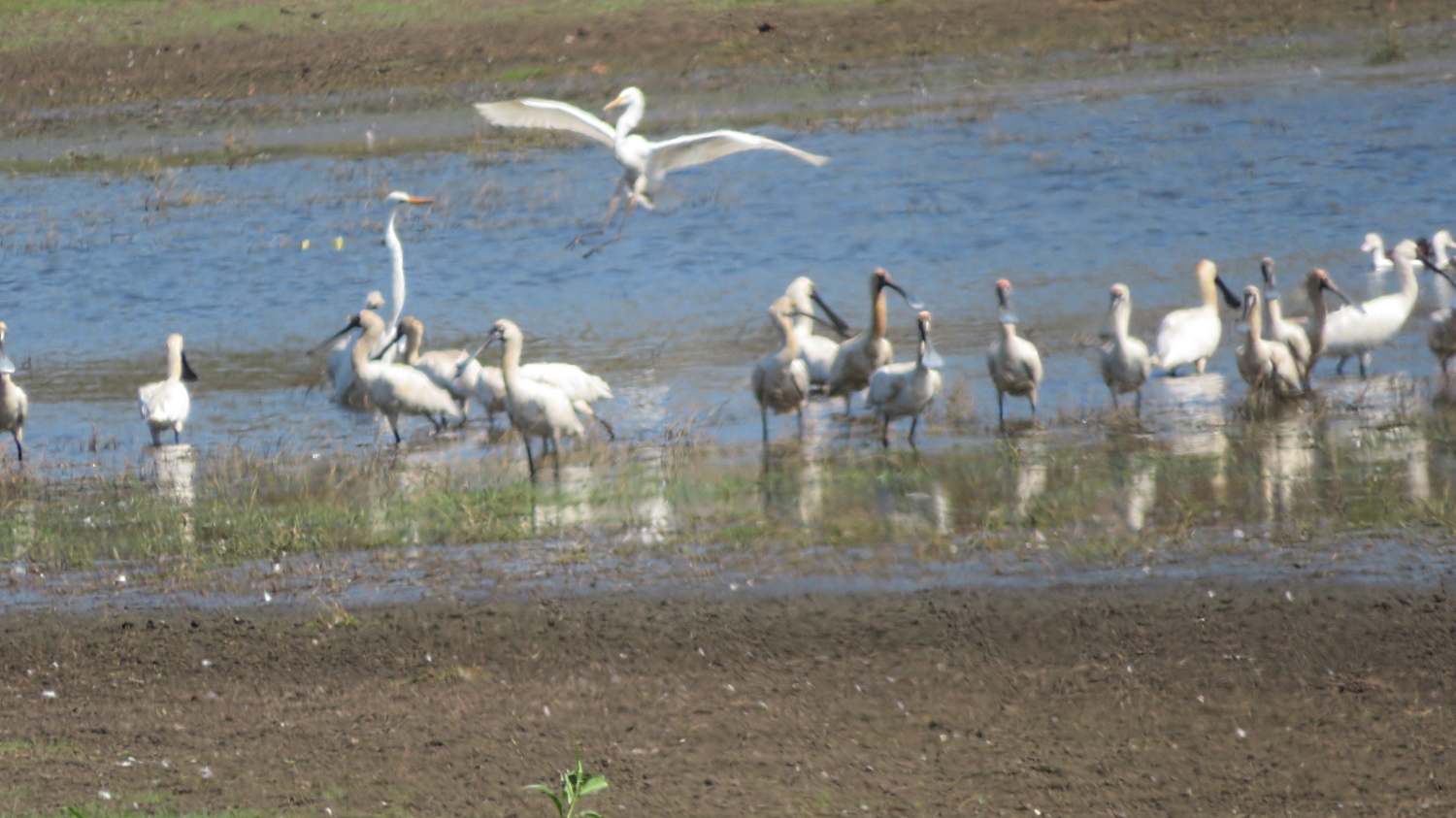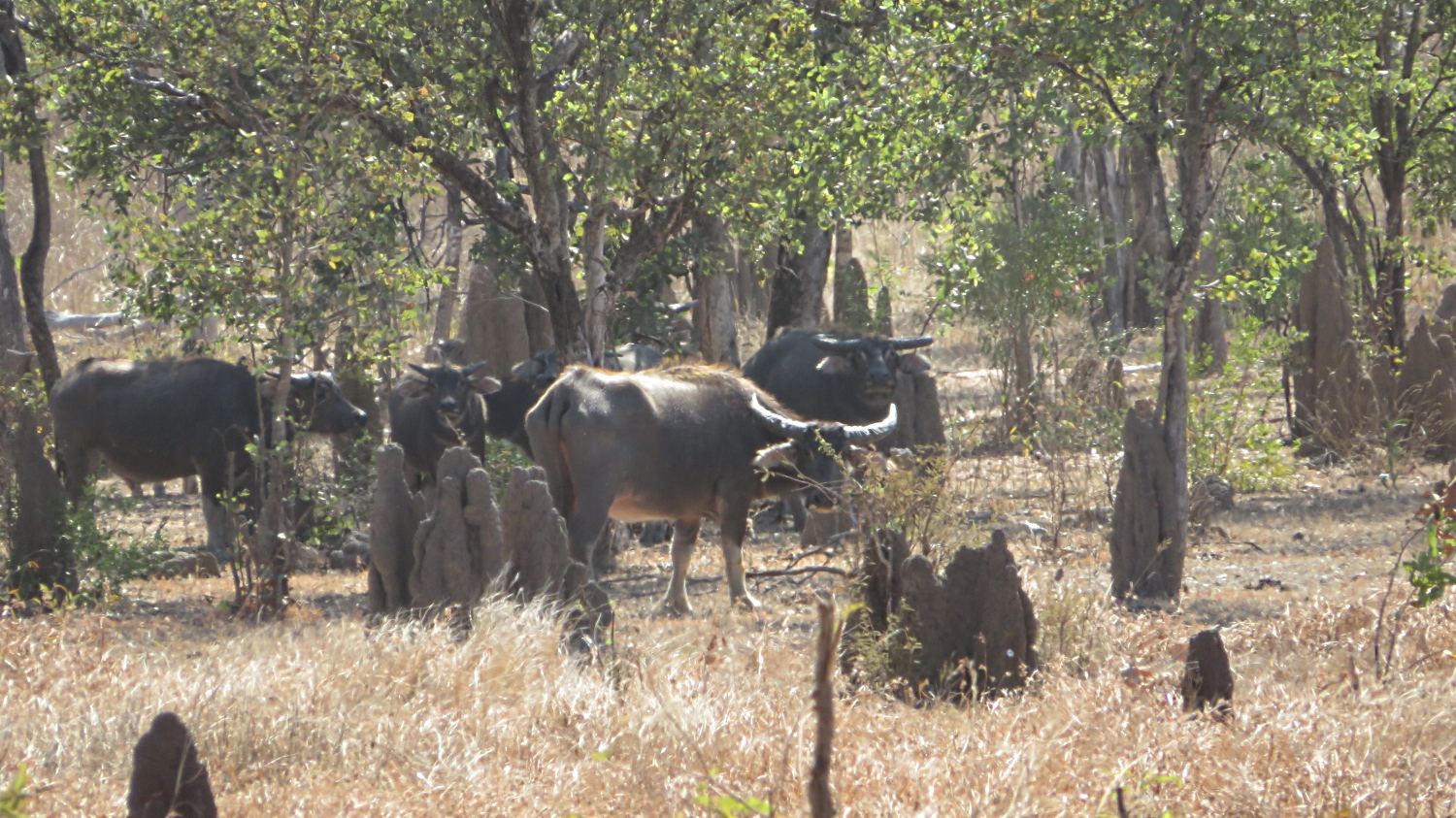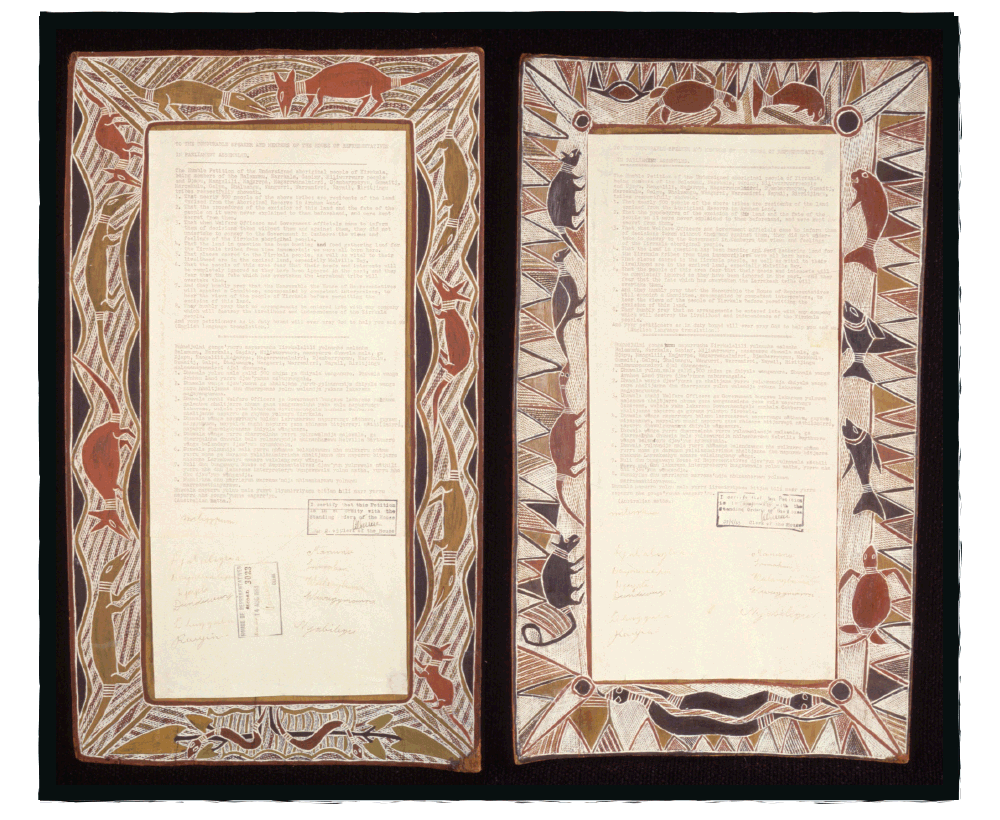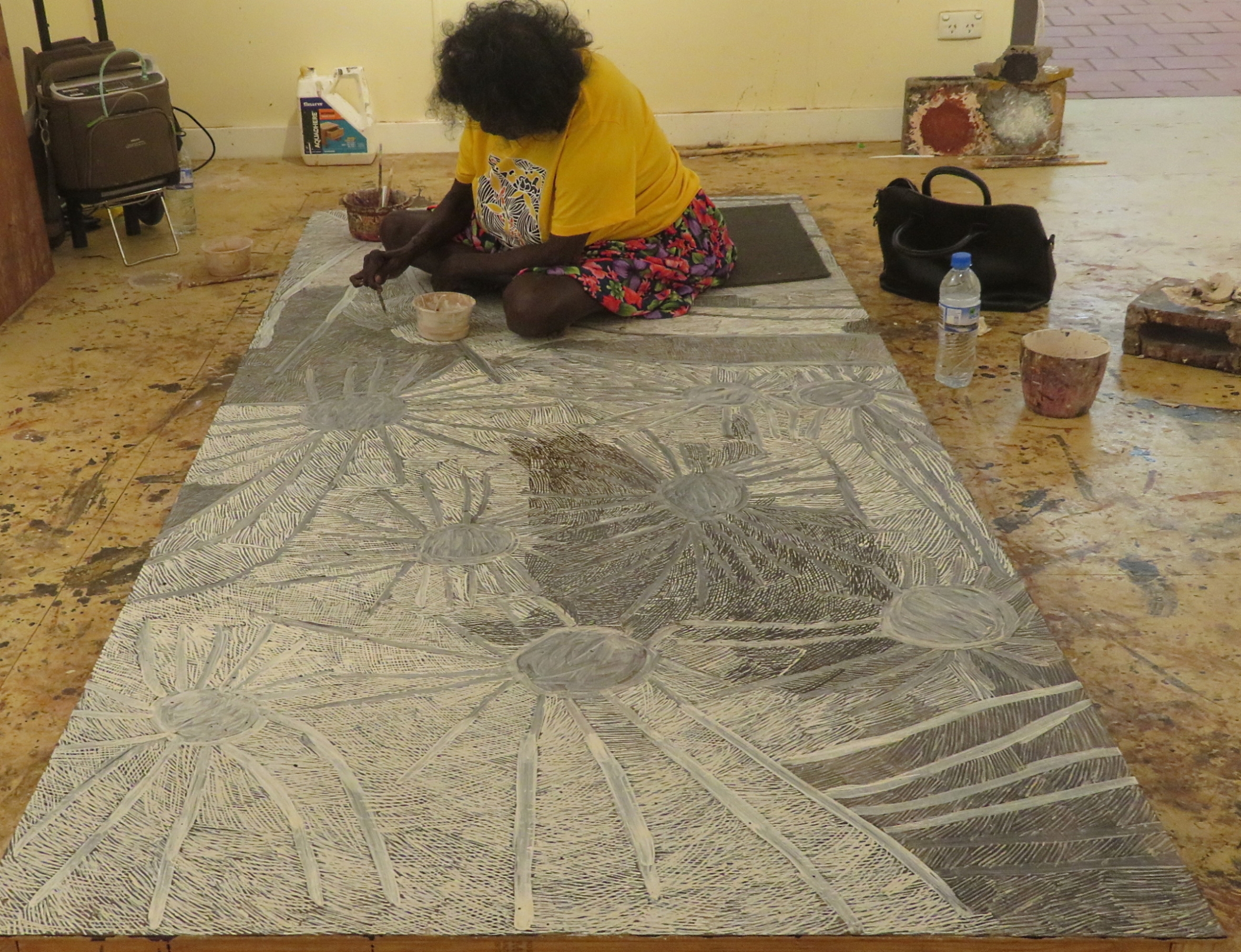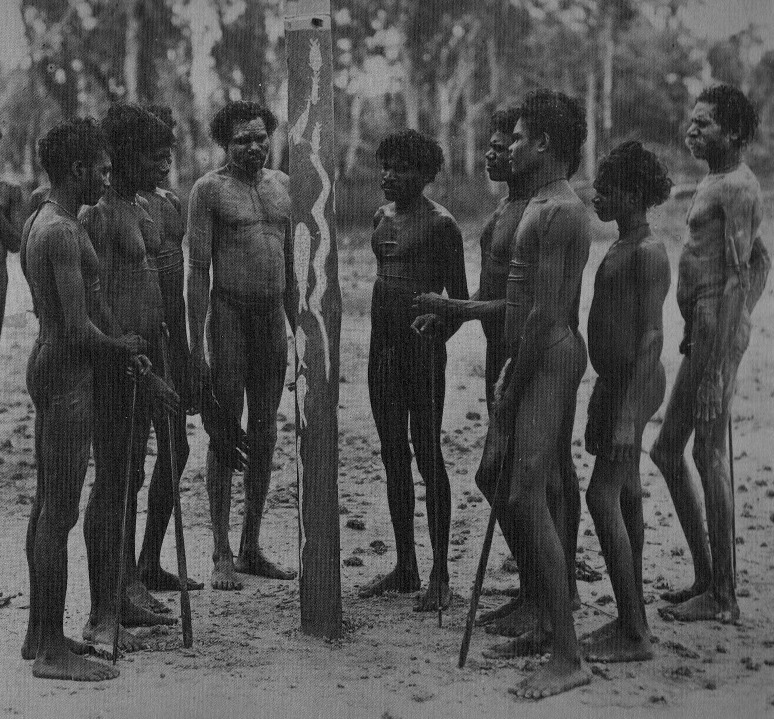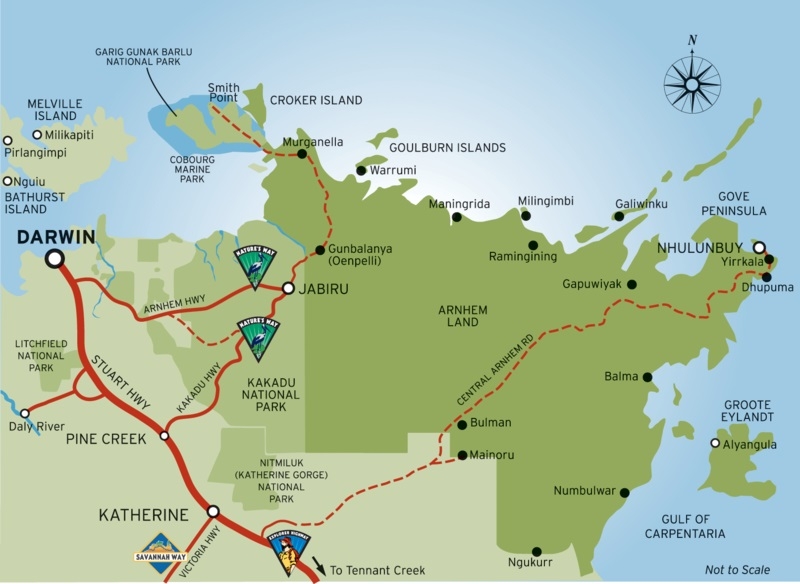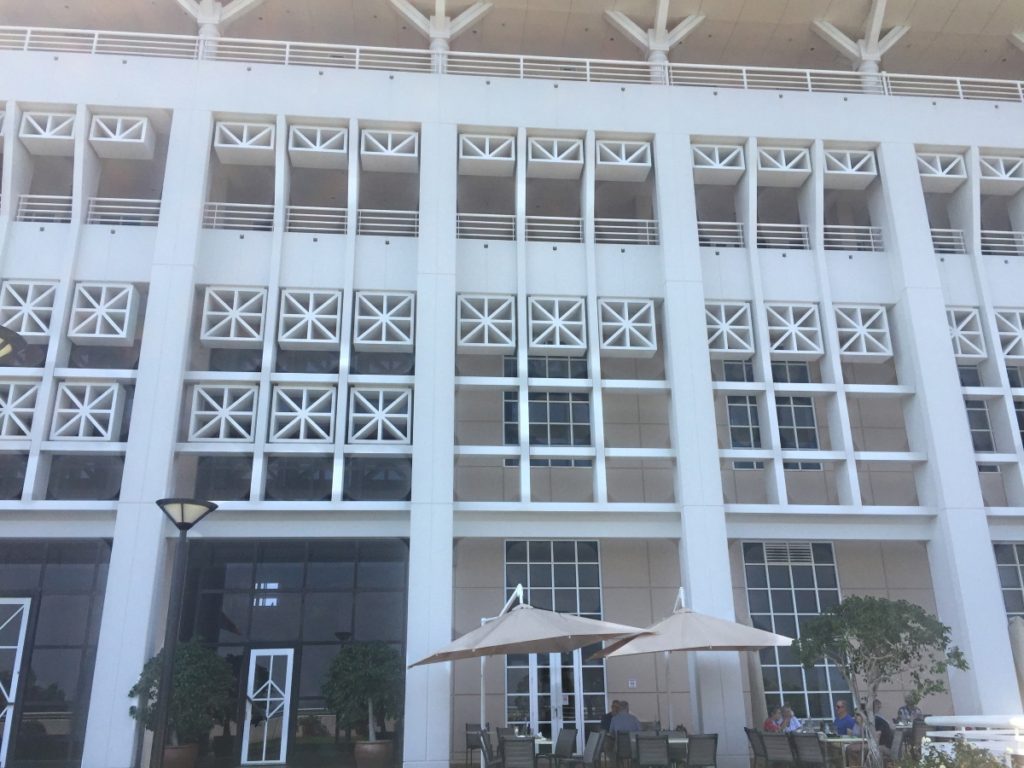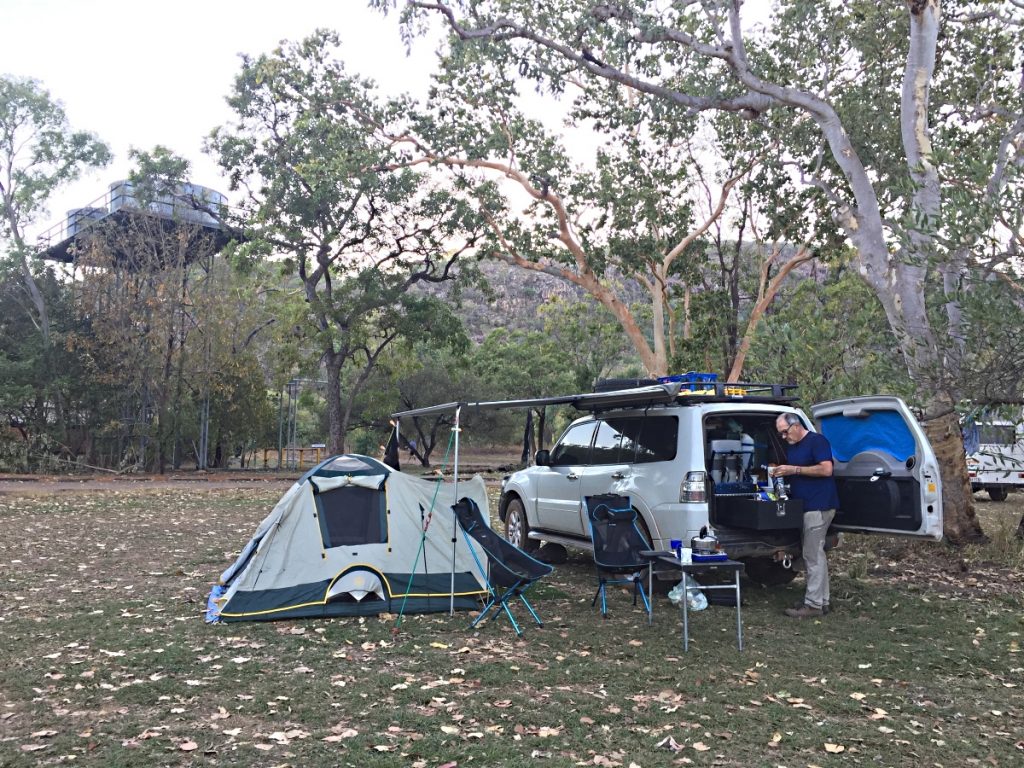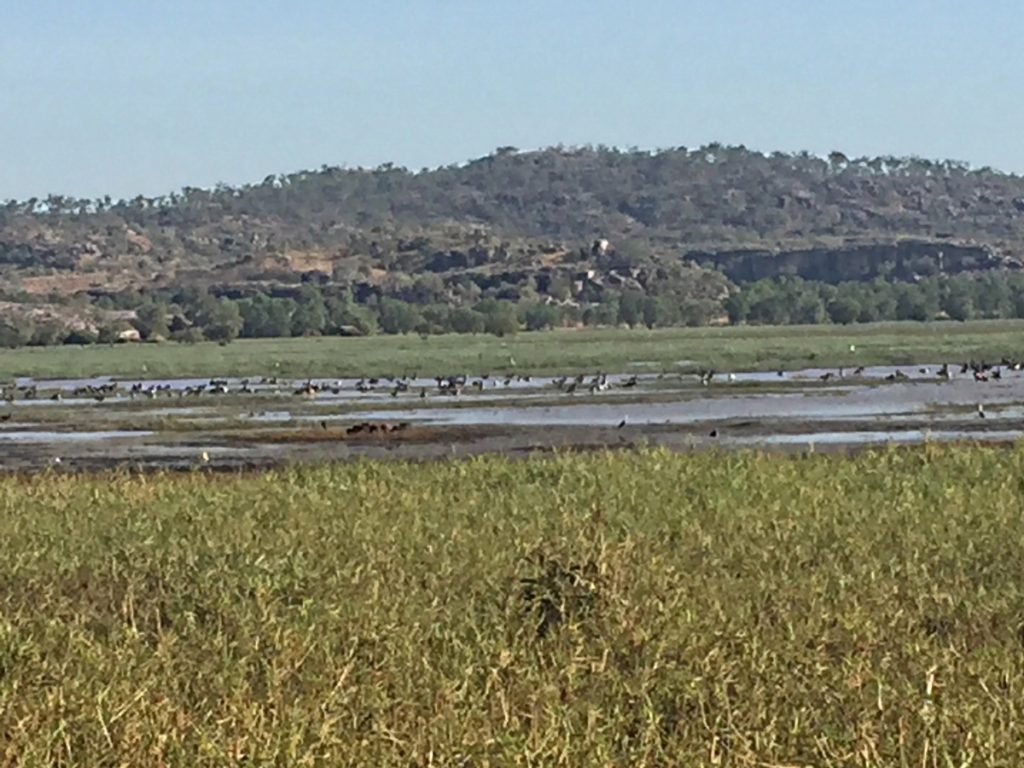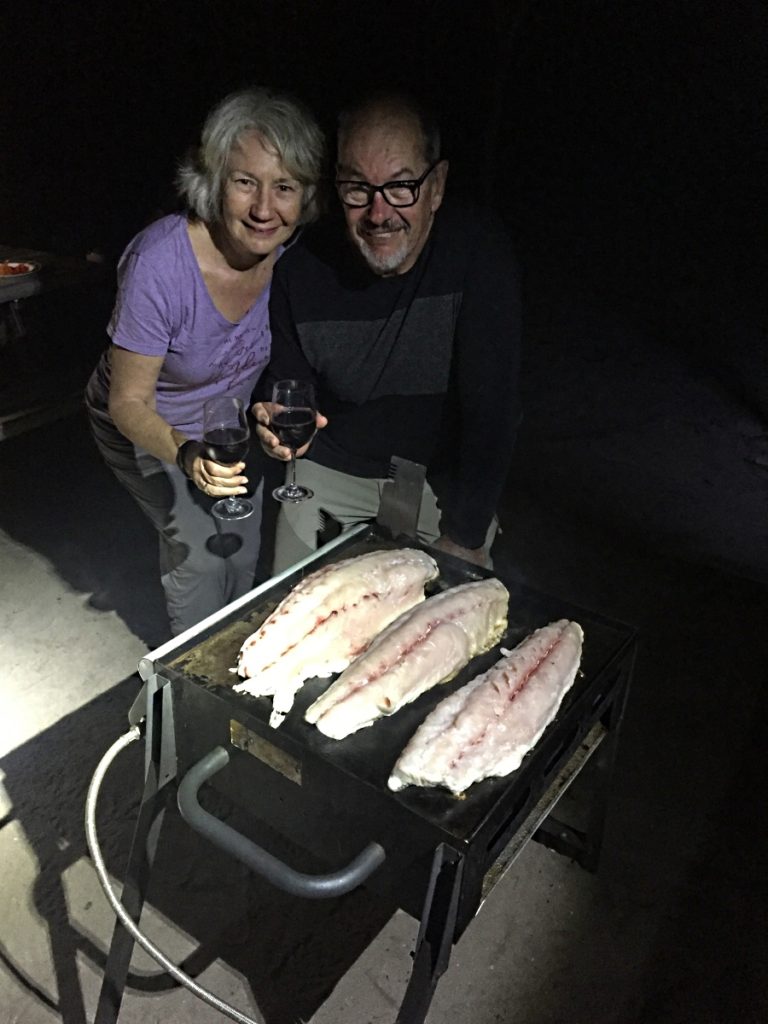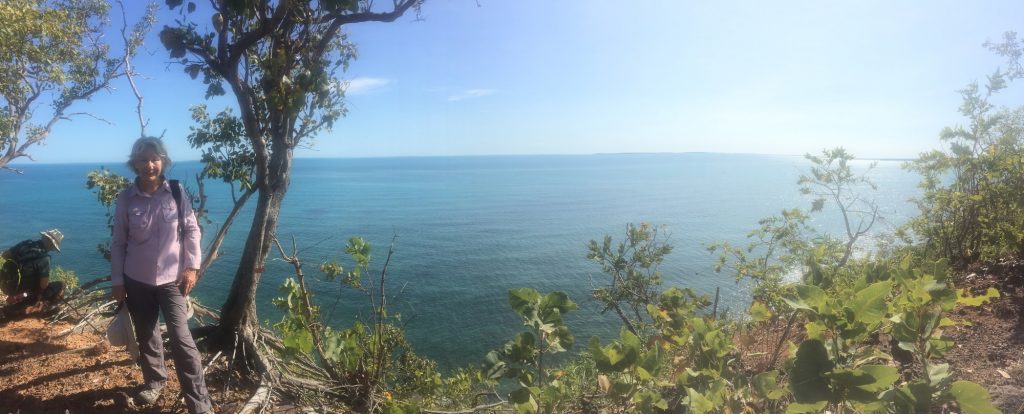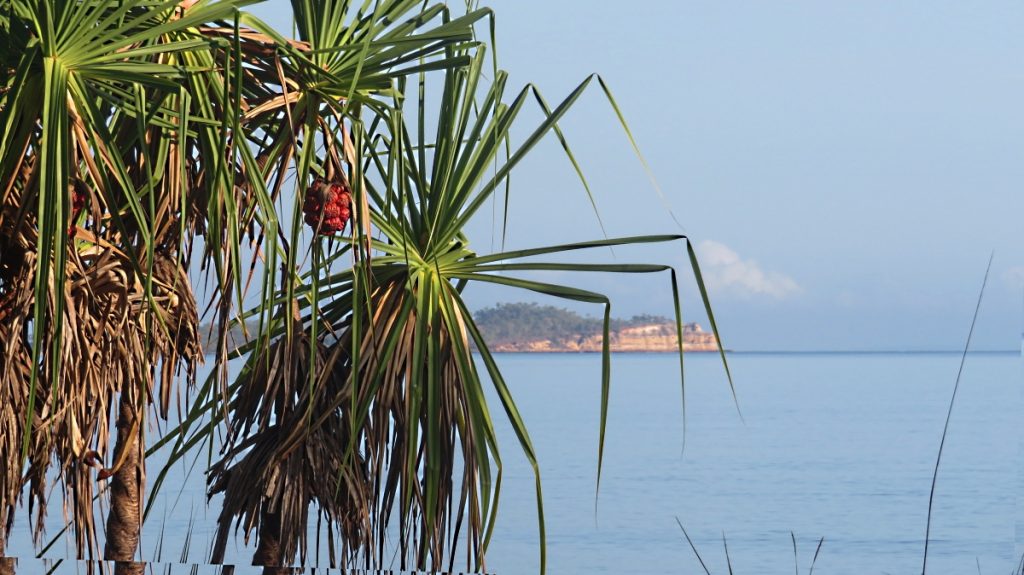16th – 28th August, 2019
This part of our travel blog describes the remainder of our August Arnhem Land adventure, taking us from Nhulunbuy to home via the Yolŋu communities of Bawaka and Baniyala in East Arnhem Land and ending our tag-along at the very beautiful Mataranka.
Friday 16th August
For the next three days we’ll be in Yolŋu homeland country of Bawaka, about 70km southeast of Nhulunbuy.
Leaving the Central Arnhem Highway after only 27km a sandy track wound its way through the bush.
Stopping to have a closer look at a field of termite mounds we learnt this type of “magnetic” termite mound is only found in far northern Australia. The mounds are 2 – 3 metres high and very narrow with their long axis always built directly north-south.

Neill teaching us about the magnetic anthills.
Neill explained the mounds have a central solid core, which insulates the east and west sides from each other. During the morning, when the sun shines on the long eastern surface the termites can be found on the western side, and vice versa in the afternoons, and in the middle of the day, when the sun is directly overhead and there’s no shade, only a very narrow surface faces the sun. The temperature difference between the two sides can be as much as 8 degrees. Other types of termites may retire to underground tunnels when it’s hot, however due to the summer monsoons and these grounds being flooded for months at a time, these termites don’t have that option. With a paucity of trees and wood these termites feed on grasses which are stored inside the mounds.
To enter Bawaka Neill opened a locked gate that restricts access and on we drove on an even narrower, even softer, sandy track until we reached the ocean before continuing along the beach.

Leaving the very soft sand inland track and now following the beach around to Timmy’s place, Bawaka.
We’re here at the invitation of Timmy Burarrwanga, one of the traditional owners, and it’s Timmy and Jason who soon overtook our convoy and led us in. Suddenly their car stopped, out jumped Jason brandishing a fishing spear, ran into the ocean some 20 metres and speared a mudcrab. How they saw it from a moving car I’ll never know.

Spearing a mudcrab for our dinner.
Bawaka means “a known heaven”, and this place is definitely that. Australia has many magnificent beaches, but the stunning blacks and reds in the dunes and rocks that meet the endless curve of the dazzling white sand beach with its shady tamarind trees and coconut palms bending over the clearest blue ocean before it meets the deep blue of the sky makes this one unforgettable.
For the next couple of nights we’ll be sleeping on our air mattresses on a large open deck just above high tide mark – and above crocodile climbing height too, I hope! Offshore we could see Nike, the 4 metre crocodile who owns this beach cruising around.
A short drive to the tip of the peninsula brought us out at Lonely Beach which we’d been told was ‘pretty safe’ for swimming (ie probably no crocs!). It’s a magnificent little cove between cliff faces, and the swimming was indeed magnificent.

Pat, heading down the cliff to the shore at Lonely Beach. We’ll swim in the cove to the left, but a lookout remained up here to keep an eye out for dark shadows moving through the water. (with thanks to Pat for the photo)
Our belief in what is wrong and right to eat will be challenged over the next couple of days. Yolŋu have protected and lived off this land for many thousands of years. They have title rights over not only the land but also their waters. Being sea people all manner of seafood has been a part of their diet, including dugong and turtles, both animals the western culture protects. This afternoon the Yolŋu men, having received permission of the elders, collected a bucket of turtle eggs and caught a turtle.

Turtle eggs.
Randy, Timmy’s assistant for our stay, had also been busy spear fishing. We all shared tastes of one of the sea mullets he caught and the crab caught earlier (but not the turtle eggs; though I’m sure they would have shared had any of us asked).

BBQing a fish and mudcrab just caught by the young guys with their spears.
This evening the elders welcomed us to country with song and dance and a smoking ceremony where we all had ochre painted on our foreheads. Jason played the yidaki, Timmy the clap sticks and sang an ancient song and Randy danced. We were asked to remove our watches and become in tune with the rhythm of the land during our stay. A liberating experience. Timmy has been actively engaged in Yolŋu rights, protection of homeland and improving the economic opportunities for his community. While white contact occured here later than in most other parts of Australia and this community appears to be more intact than most, it was still not innocuous.
However the evening wasn’t all ‘deep and meanifuls’. Timmy told us the story of the first tractor in East Arnhem land and we danced and laughed to the ‘tractor song’.
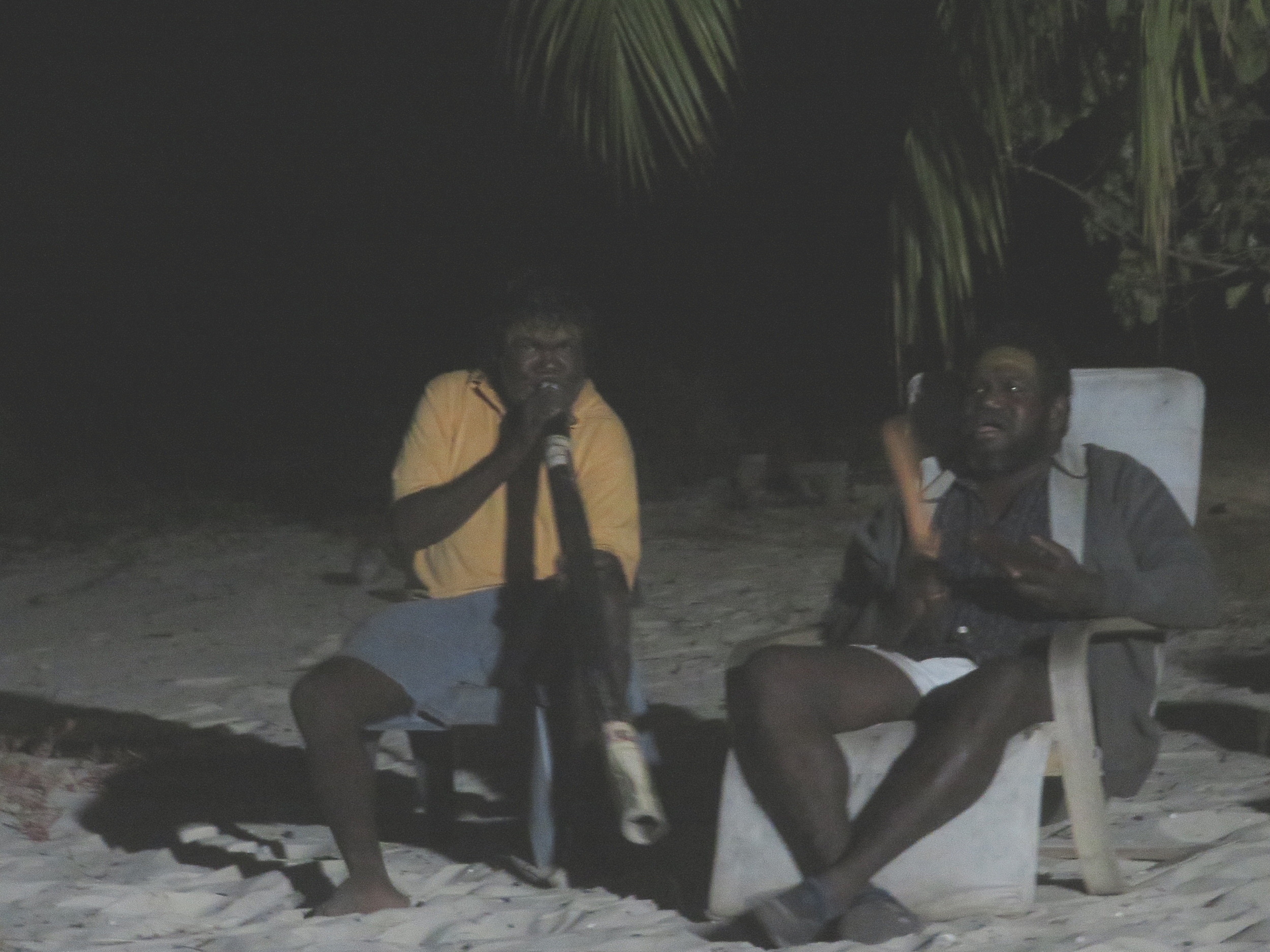
Timmy on the right. Jason playing the yidaki.
Timmy told us Nike’s story. Nike, the 4 metre crocodile, was named in honour of Kathy Freeman. At the time Kathy was in the area for a photo shoot Randy rescued a baby crocodile caught in flotsam. He brought it up as a pet until he became just a bit too big and demonstrated his natural instincts! Nike still comes when called, but is afforded a very healthy respect. At one time when I was standing near the water’s edge with my back to the ocean I was told by Randy in no uncertain terms to come away and never to do that again – I didn’t!
It was a delight to lie in bed tonight on my little mattress on the wide open deck listening to the gentle lapping of the waves and watching a million stars twinkling – a creation story in each. (No mozzies!) What a privilege to be invited to share a tiny portion of the lives of our first Australians.
Saturday 17th
Slow start this morning. It was very foggy, which Timmy tells me is quite unusual. Mind you the little bay looks so ethereal in the fog.

Foggy morning at Bawaka. Very unusual I’m told.
Nike the crocodile is just offshore, watching … I think he knows there’s going to be a feast for him today.
Timmy and Randy and Jason prepared the turtle for cooking today, with some help at times from Paul, Steve Orr and Neill. The rest of us just looked on, or walked away as it was quite confronting. Of course it’s easy to rationalise that we eat other meats and this is no different; however when it’s not part of our culture, quite the opposite, and it’s such a beautiful creature, it’s a little difficult.
If you don’t wish to read about it then skip reading from this photo until the next one.

Nike. Thank goodness for long-range lenses. No desire to ever be this close to the gorgeous little critter.
Timmy, Randy and Jason started preparing the turtle for cooking. After the turtle was killed, the head and entrails were removed and wild herbs placed in the cavity. Hot rocks from the fire that had been started earlier were layered on top of them and then topped with grass clumps to keep the steam and heat in. The turtle shell was left standing upright to begin the cooking process.
After some time the turtle was placed on the fire, underneath plate down, then turned over and the outer shell charred. The meat was only partially cooked when it was taken off the fire. The remainder of the cooking will occur just before it is to be consumed. The underneath shell of the turtle was cut and levered off, then Timmy began the difficult, strenuous and precise job of butchering the turtle. The meat was washed and divided into large pieces to share with extended family. Nothing that could be edible was wasted – the intestines were rinsed out to be cooked and eaten too.
Timmy BBQ’d some intestine and liver for us to taste … I guess you could develop a taste for it, maybe.
All the inedible parts, ie the head, fins, etc, including the shell, were fed to Nike. Randy would call him and slap the water with the food for him and he’d come silently cruising in. Randy put the food high up the beach where Nike would lumber up to get it before returning to the water to eat it. A happy croc, but not one I’d like to get anywhere near.
To view the photos taken of this process CLICK HERE.

Randy calling Nike in to take the carapace of the turtle. You can see just his eyes out of the water and the shadow of his body. He’s swimming in. Notice there are no ripples at all. Also notice that Randy is watching him very closely.
A few more fish were caught today. The keen fishermen in our group went around the other side of the bay with the local men and all came back with fish. Our guys used fancy, expensive fishing gear; the locals used spears.

Never lose an opportunity to spear a fish. Note that Randy is holding a woomera attached to the top of the spear to assist with force when he throws it.
We had a big bonfire on the beach this evening and another very moving group talk with Timmy. Amongst other things he explained the way everything is divided into yirritja and dhuwa – like ying and yang. We were challenged when asked to reflect on our knowledge and beliefs of our country’s first people.

Yirritja and Dhuwa are the two moieties. Yothu yindi translates as ‘mother child’. Everything in Yolŋu life belongs to one of these moieties and they determine how people interact with one another and the country in which they live. It is a very complex and extensive system.
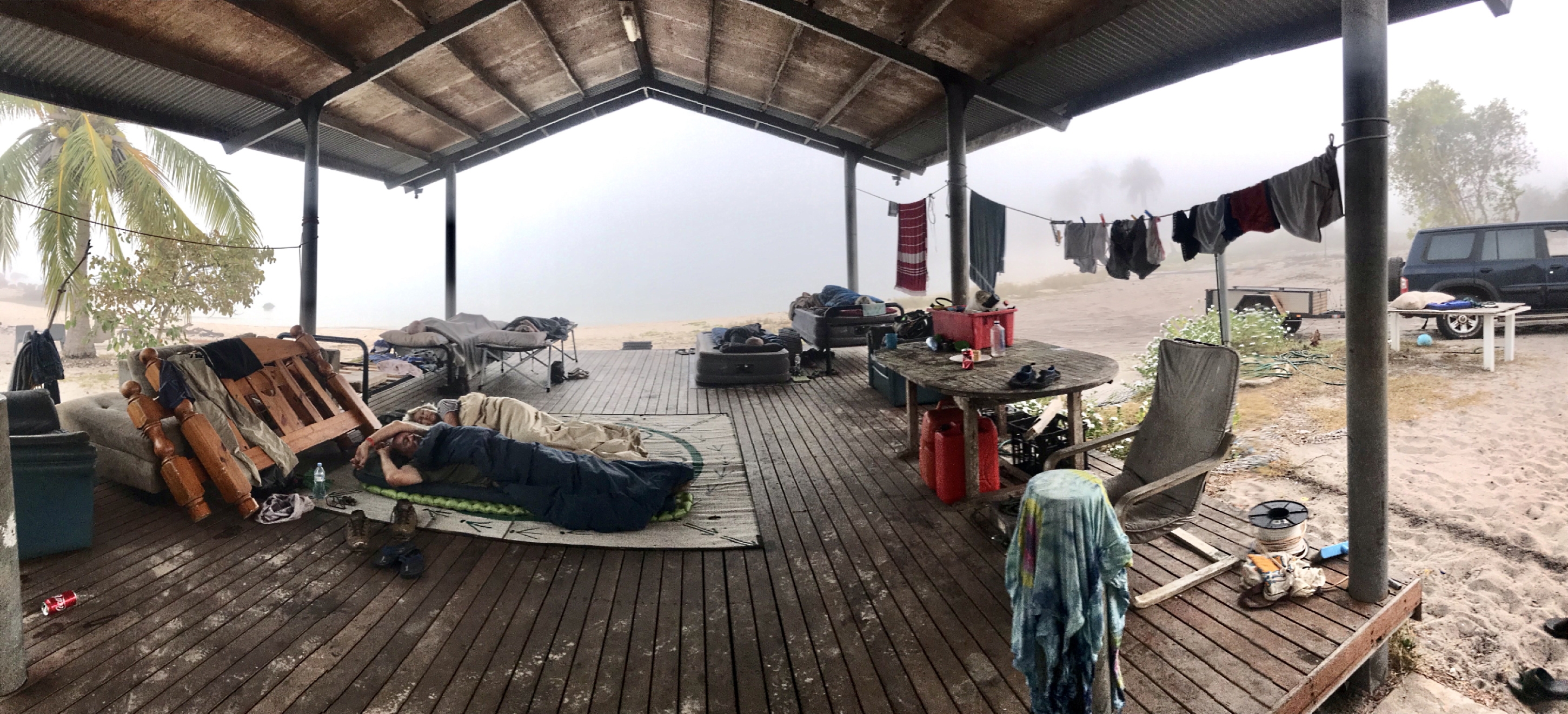
The open deck on which we slept for a couple of nights. Such a pity it’s a foggy morning when this photo was taken. You can see through the fog where the water is. That’s us on the mat at this end. Julie and Paul are sleeping on the stretchers to the far left of the photo and Steve and Jo on the big blowup mattresses on the far right of the deck. And no, none of the clothes and stuff lying around is ours. Others were sleeping either in the bunk house, or several had vehicles in which they could sleep. (thanks to Pat for the photo)
Sunday 18th
Quite a few of Timmy’s relatives began arriving yesterday from Yirrkala where the family lives. As well as the extremely talented artists whose artwork I showed in my last post, Yirrkala is also the home to several members of the successful music band Yothu Yindi and the award winning singer and musician Geoffrey Gurrumul Yunupingu. No, sadly, I’m not leading up to saying that we had a private concert from Yothu Yindu, just letting you know where they came from and yet another illustration of the talent in this area.

I love this photo of Randy fishing.
One such talented person that I hope we may hear more of sometime in the future is Sienna who is completing year 12 this year and came over to chat with us about her life and dreams and aboriginal culture. A very impressive young woman.

The lovely, vivacious Sienna who spent some time talking with us about her life and plans.
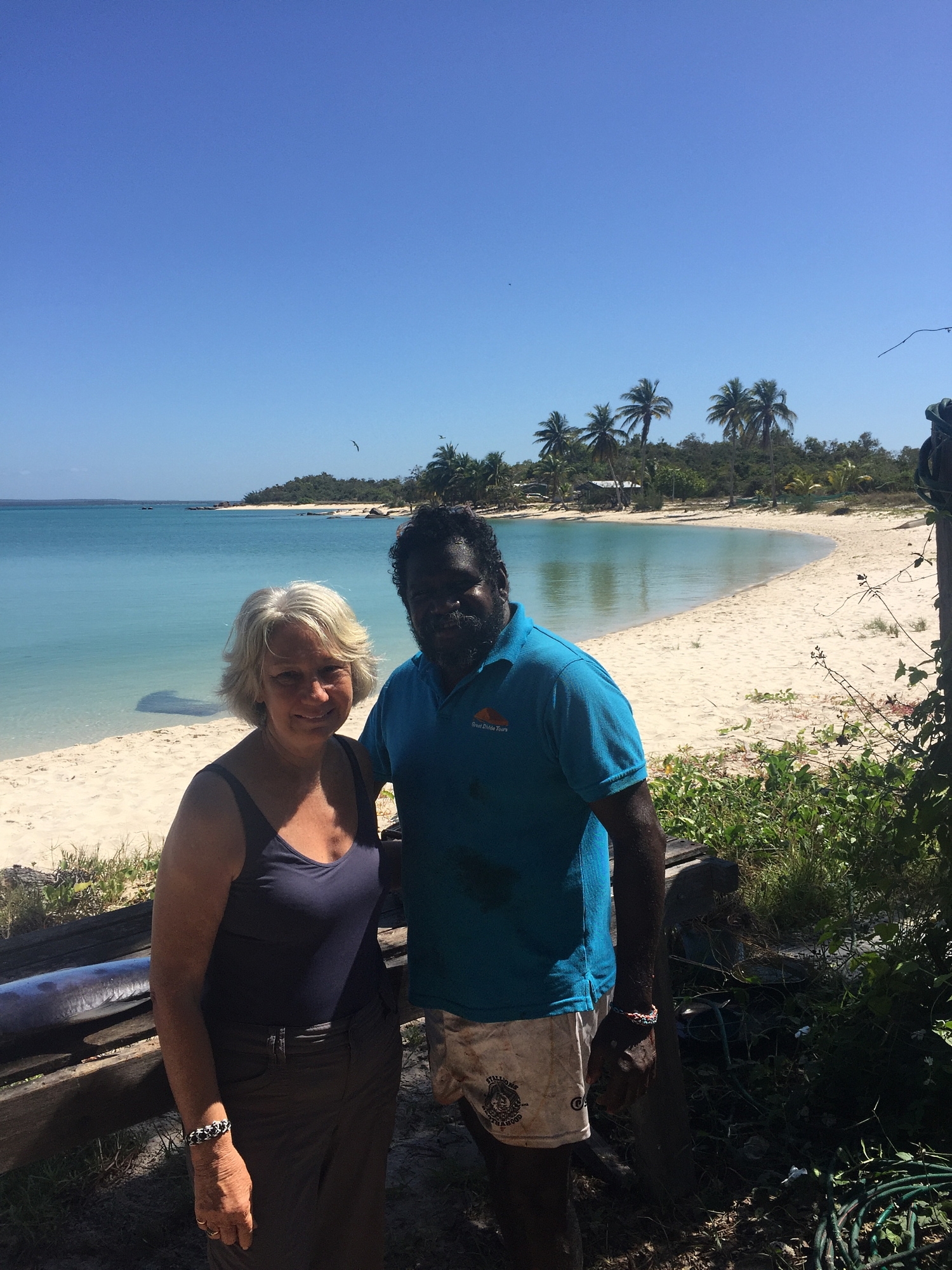
Timmy and I. He shared his homeland and his life with us in a very generous way. What an amazing experience!
One of the family is to be married next week and another turtle was caught and prepared today, all the meat going into the fridges ready for the celebrations.
We packed up and left late morning, once more honing our 4×4 driving skills on sand that is so soft you knew if you stopped you’d be bogged. Someone had left the gate open and a random tourist, without permission, had started down the road and was very quickly bogged, blocking the track completely. While Neill was assisting them, and our convoy was all parked sporadically on any firm piece of ground we could find, another of the locals started to come in. I was amazed to see them leave the track completely, the passenger got out and, walking in front of the car, guided the driver through and around obstacles as they made their way through the bush and past us.
Back in Nhulunbuy for our final night here we shopped, refuelled, washed and generally sat around marvelling at the most incredible experience we’d all just had … and snuck our watches back on.
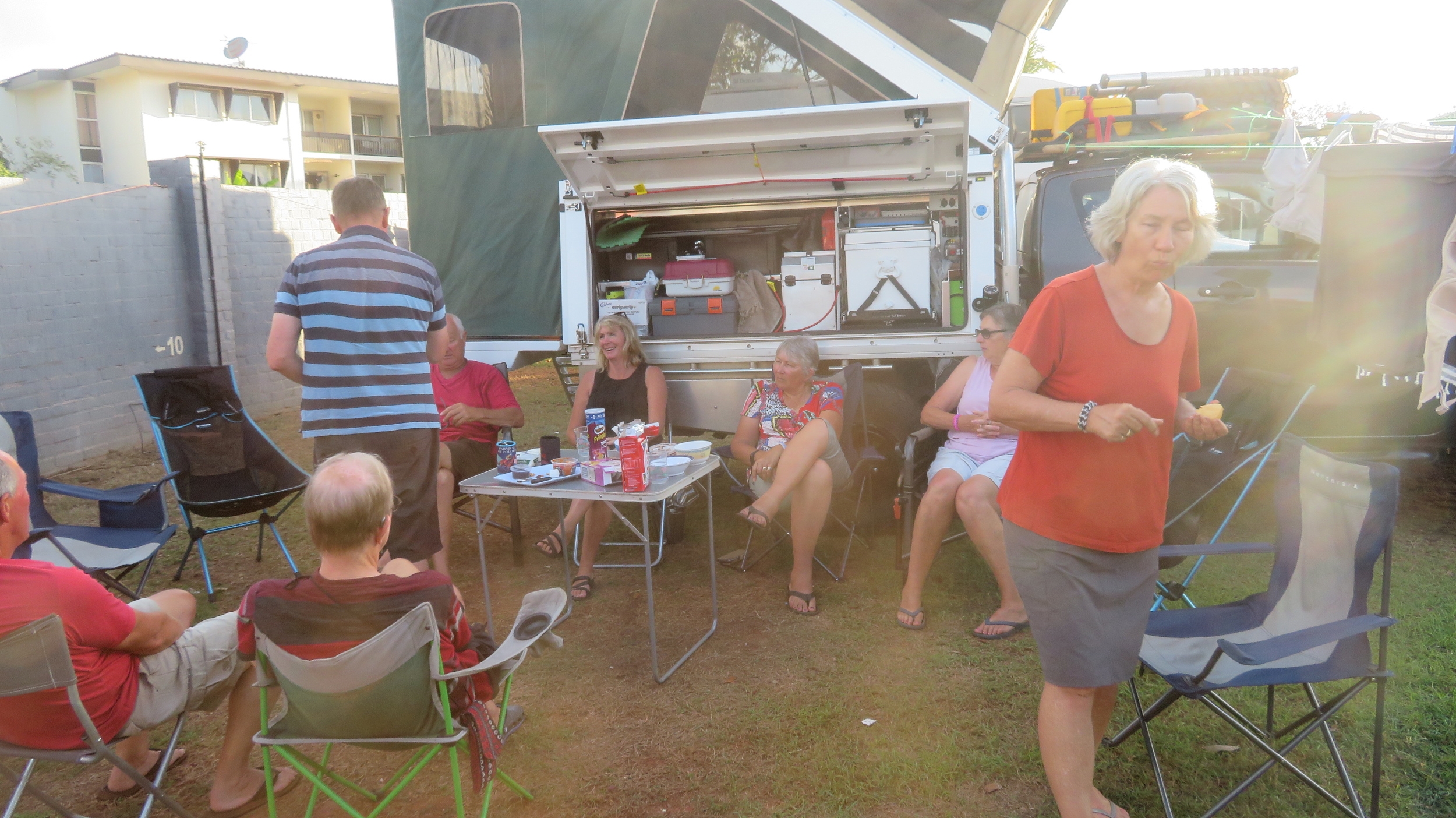
Back in Nhulunbuy, chatting about the very unique time we had at Bawaka.
Monday 19th
After a last visit to the bakery we headed back onto the Central Arnhem Highway, then along the track toward Baniyala.

Lunch break on the way to Baniyala. Only occasionally did we see oncoming or passing traffic on all of these roads.
We drove on past the Baniyala turnoff to the National Parks camping area at Dhuluwuy Bay where we set up camp just metres from the ocean.

Oh it’s us! Dick, Steve, Denise and Pat. World problems solved!
Admiring the view over Blue Mud Bay towards Groote Eylandt and into the Gulf of Carpentaria didn’t seem to tire us until well after a beautiful full moon rose.

Moonrise over Blue Mud Bay. Wow, could life be more perfect.
The disadvantage of being right on the cliff edge overlooking the ocean, is the wind – blew lots tonight making sleep sporadic.
Tuesday 20th August
As a form of thanks for the unprecented access we’re granted by the local communities to share their lives, Neill takes every opportunity to contribute where he can; an example was the beach clean-up we did earlier. Today several of our group went with Neill into Baniyala to fix some tents that may one day become a tourism venture.
We joined them late morning and went up to the community where we were met and shown around by one of the elders. For many centuries they’ve had a sand representation of their lands, which is where they hold all their ceremonies. This is cared for and repaired as needed.

This large sand sculpture, which has been here for many, many years tended to as necessary, represents their land in relation to other places plus the sea and the clouds. (Photo courtesy Pat Evans)
The stingray is of great importance to this clan. They are able to show, by a huge indent in the ground, where the stingray came ashore back in the Dreamtime.
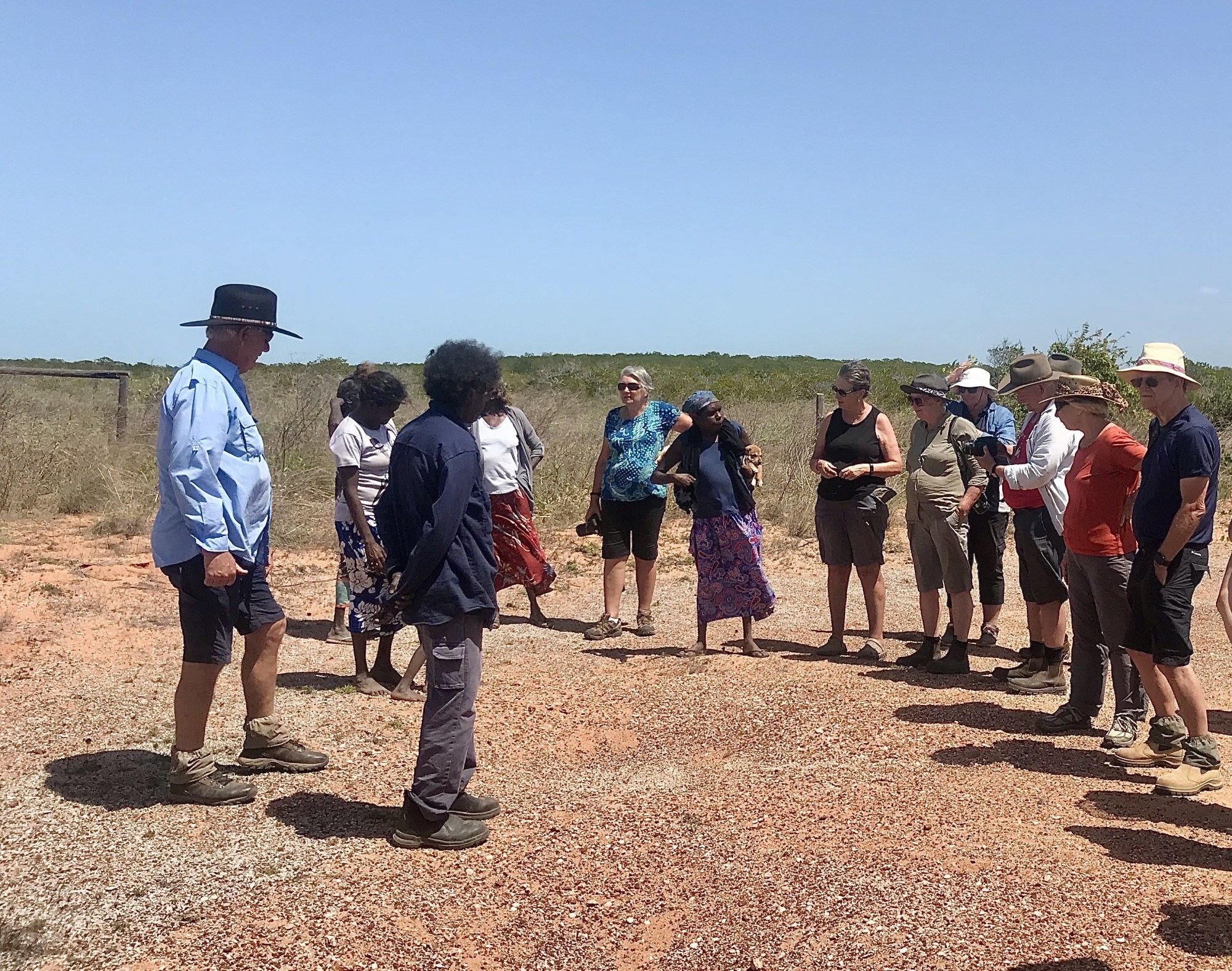
Here we are looking at the stingray sand sculpture. They take sand from the eye holes and name the places they plan to hunt stingrays, which helps them on the hunt. (Photo courtesy Pat Evans)
Graham is the man who took us to see these important aspects of their lives. He is also a very accomplished artist, working in sand painting. using coloured sand he makes beautiful designs on bark and logs.

Graham, the artist explains to us how he paints first with glue then sprinkles the coloured sand he needs over it.

Two beautiful completed sand art works by Graham – made on commission unfortunately. I would have loved to have bought one.
After lunch the locals took us out of town where we women were dropped off while the men drove on further to a large lagoon where they saw brolgas, emus, heaps of birds and even more mosquitoes, so I’m told.
The indigenous women started by looking for a pandanus palm that had fronds that would be perfect for weaving. When they found it they chopped it down and sorted out the fronds they wanted into a big bundle.

The pandanus palm has been cut down and suitable fronds are being stacked, ready for drying and eventually making one of the wonderful woven baskets they are so famous for.
Then they began to look for a tree that would contain a native bees hive, and hence honey. We all walked around for ages, spreading right out. I was completely lost, so just followed one of the local women. The tree we were looking for would probably be a stringy bark, that was hollowed out by termites and where they could see the bees flying in and out of a small hole. The call came – one had been spotted. Despite staring very closely I couldn’t see any bees.

Ah ha, found one! Look – tiny little native bees flitting in and out way up at the top of that tree! Better eyesight then I have!
The oldest of the group of women took the axe and chopped the tree down, then cut a hole where they guessed the hive was. Sure enough, lots of beautiful, dark honey flowed. A pot was placed under it and the honey flowed in. It was really delicious honey – such a rich, sweet taste.
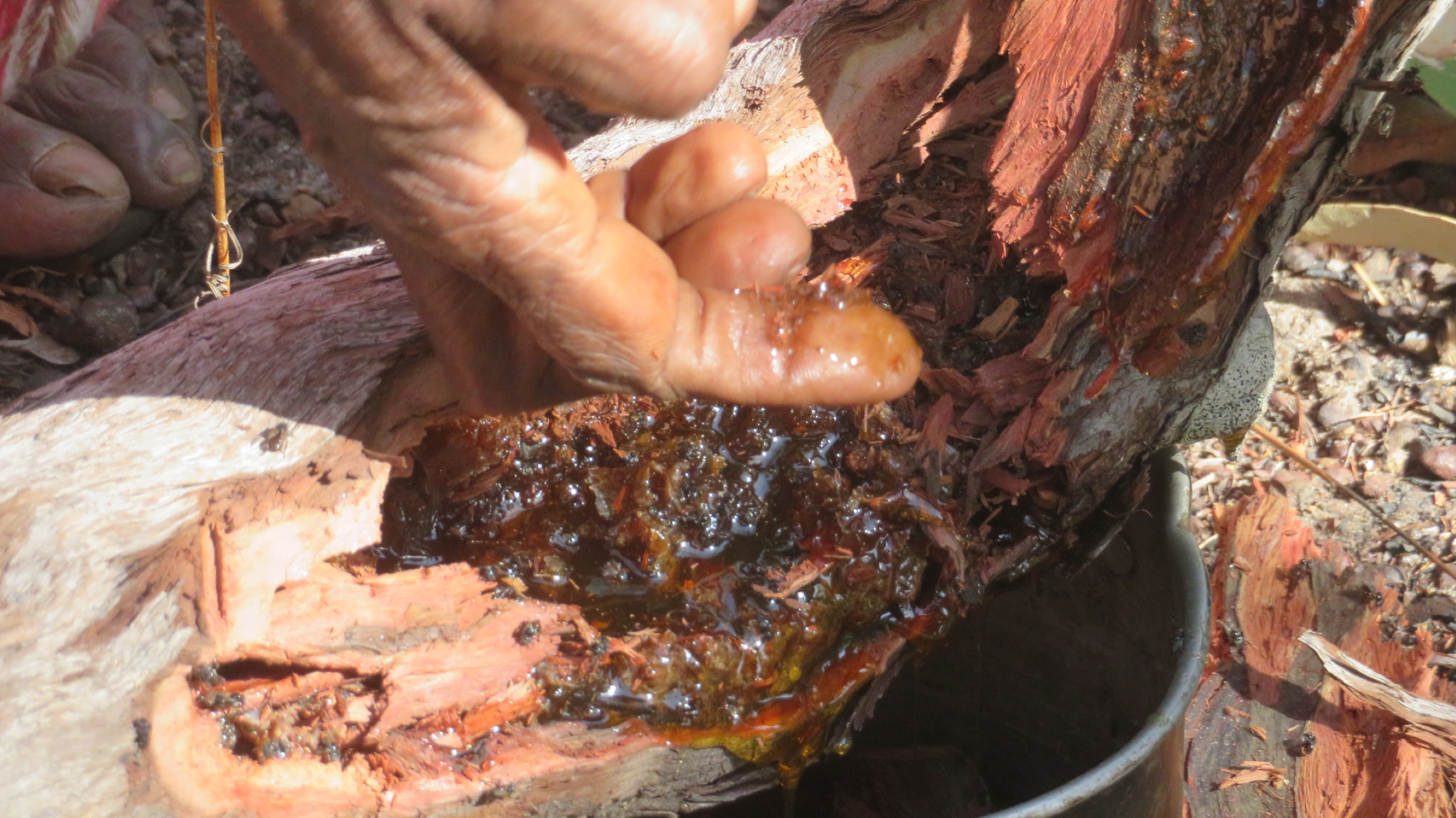
Look at that beautiful, dark, rich honey. The honey is dripping into the saucepan under the log.

The saucepan nearly full of honey – and a bit of bark.
The women gathered all the honey and the pollen which would be eaten, and also the wax, which would be kept for molding mouth pieces for yidaki. Yet another very unique opportunity to share a little of their way of life.
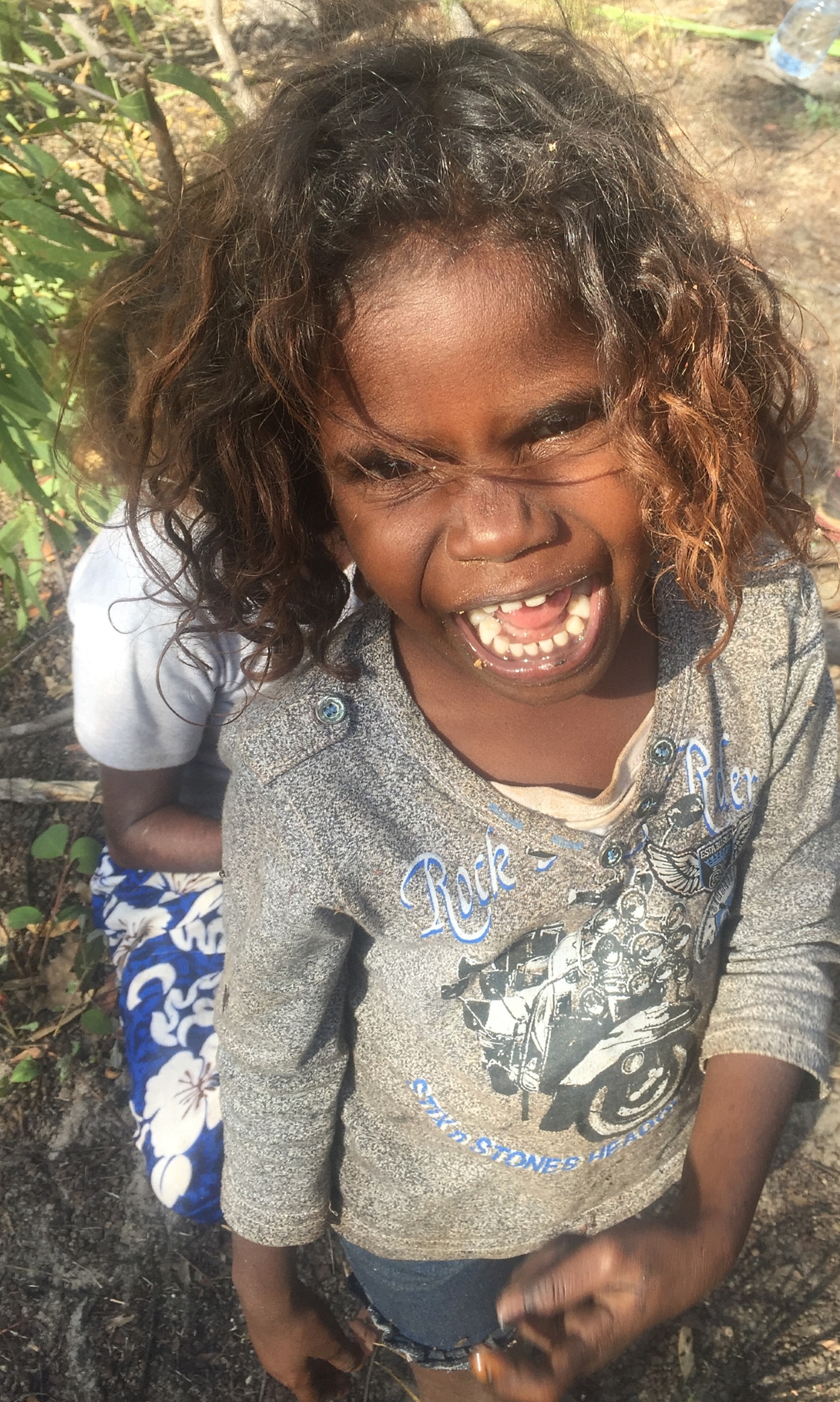
Cheeky boy – how come all boys this age are so adorably cheeky!
Back at camp we lit the campfire, though it was still blowing a gale. We BBQ’d our meat for dinner and spent the evening solving the World’s problems with Pat and Dick. We then slept surprisingly well, despite the wind. Maybe because the toilets and showers were easily a 500m walk away from our camp – all that exercise!
Wednesday 21st
Leaving this morning at 9am we rejoined the Central Arnhem Hway and headed south. Parts of the road were wonderful, recently graded gravel that we could travel at 80-90km/hr. Other parts were bad: corrugations, stony, bull dust holes, washouts – a mixed bag.
As we’ve travelled these roads we’ve frequently seen slow burning fires. Some of these have been lit by the rangers doing a controlled burn to reduce the fuel load preventing serious bushfires later in the dry season. But many of them are caused by lightning strike, or discarded cigarettes or mischief-makers. Another cause could be the ‘fire birds’. You’ll often see kites (the raptor) flying just in front of a fire catching the small ground animals fleeing from the fire. These birds have learnt to pick up a burning stick and drop it in another spot if this fire is going out or not producing enough fleeing animals.

Slow moving fires are very common in the Top End at this time of the year. No fires should be lit after August 1st, however this is not adhered to, obviously, and is often quite random rather than planned.
There is some contention about the amount of burning that is happening. A return to the fire management regimes of the traditional owners is being strongly encouraged.
It was a long driving day, broken up with stops at the bridge we bypassed on our outward journey and Bulman where an ice block from the local store was greatly appreciated.
We saw lots more feral animals too – buffalo and donkeys.

Buffalos grazing by the side of the road. These can be very dangerous if they take it into their heads to cross the road as you get there.
Eventually arriving back at Mainoru Store we once again appreciated the grassy campsite beside the springfed brook, the flushing toilets and the warm-ish showers. Dinner tonight was once again provided by the Store: beef and salad (tough as).
Early night – exhausted after a long day.
Thursday 22nd
Our last day of the tag-along!
A long drive continuing along the Central Arnhem Highway. Lots of buffalos, donkeys, cattle to be seen. The landscape and flora changed subtly as we travelled from driving along the ridge to down in the valley. Once more we stopped at Jurassic Park – only buffalo in the park thank goodness, no dinosaurs, though it wouldn’t surprise me.

The sunken valley of Jurassic Park. You can see the cliff edge on the far side where it once more rises to the usual level.
A craft shop at Beswick was open, though the highlight was their museum of artwork. In 1996 local elders and renowned digeridu player and artist David Blanasi conceived of the idea of putting together a collection of art to showcase and celebrate the strength of Indigenous culture in the area. The most famous of the artworks have an interactive installation where an animated story plays on a tablet when pointed at it.
Blanasi himself had an interesting history bringing the digeridoo (bambu in his language) to international fame in 1967 after giving digeridu lessons on the very popular Rolf Harris television show in London. Following the death of a very close friend of his, in 2001 he went missing in the bush with no trace since.
Unfortunately there were few of the commmunity around as they were experiencing “sorry business”.
Here the blacktop began and we gleefully farewelled the corrugations and dust.
Once on the Stuart Highway we headed to Mataranka where we camped at the crowded caravan park, did the washing and headed down to Bitter Springs. Heaven on a stick! This 500m waterway is fed by an underground spring that gently flows down a watercourse lined with cabbage palms. With a noodle hired from the CP, we were able to float gently down the stream. The water is crystal clear, right to the bottom, which is well over my head – so crystal clear it looks icy blue, though icy it wasn’t, just delightfully warm. Only downside is the number of people we share it with.
Back at camp we’re all going for dinner at the CP up the road – lots of fun, nostalgic saying farewell to everyone with promises to drop in when passing, and delicious food.
Everyone really appreciated the great job Neill Bell, our knowledgeable, energetic but ever so patient leader did, ably assisted by his wife Gail.
And so ended our tag-along.
Friday 23rd – Tuesday 27th August
Homeward bound.
We packed up early, then ducked down to the Springs. Glorious! Only us and one or two other couples this morning, so we were able to thoroughly enjoy a relaxing and quiet float. These Springs are absolutely amazing – if ever you’re up this way, take time to enjoy them.

The very beautiful, artesian-fed watercourse lined with cabbage palms. Unforgettable.
Got away about 9am taking turns with the driving. We headed south on the Stuart Highway before heading east on the Carpentaria Highway as far as Heartbreak Hotel at Cape Crawford. Grassy site for the tent.
Two big Brahman bulls wander the campsite grazing on the green grass, coming into the outdoor eating area and drinking water directly from the sprinklers. They entertained us for awhile, though there was a little fear they may wish to investigate our tent while we sleep.

One of the two Brahmans that wander the hotel and camping grounds. What was most entertaining is when they drank from directly from the large sprinklers that keep this grass so lovely and green.
Saturday: Early start heading south on the Tableland Highway. Mixed feelings about this drive as it is a good road and a bit different to the main highway south, however the fields were absolutely bare other than for the carcasses of cattle that had starved to death. We soon headed east across the border back into Queensland where we met up with Pat and Dick in Camooweal in time to take in a little local culture – the Queensland camp drafting championships. We arrived in time for the evening festivities – several entertainers including a very talented young man who cracked a burning whip in time to music – you really needed to be there to appreciate it.

A big horse event happened here today. Now there’s just the music, the bar and the BIG hats to go. Camooweal
Sunday: Both vehicles headed off to Winton today via the Barkly and Landsborough Highways. At the Winton caravan park we had the pleasure of being entertained by a bush poet.

Grazing the long paddock. As you can see there’s not too much here for the poor damn animals to eat either. So dry. Following Pat and Dick on the Landsborough Highway

Barcaldine and the Tree of Knowledge.
Monday: We lunched together at Barcaldine before sadly farewelling our newest friends as they hurried back to their home in Sydney and we scuttled home as fast as we could to avoid sleeping in the tent any longer than we had to.
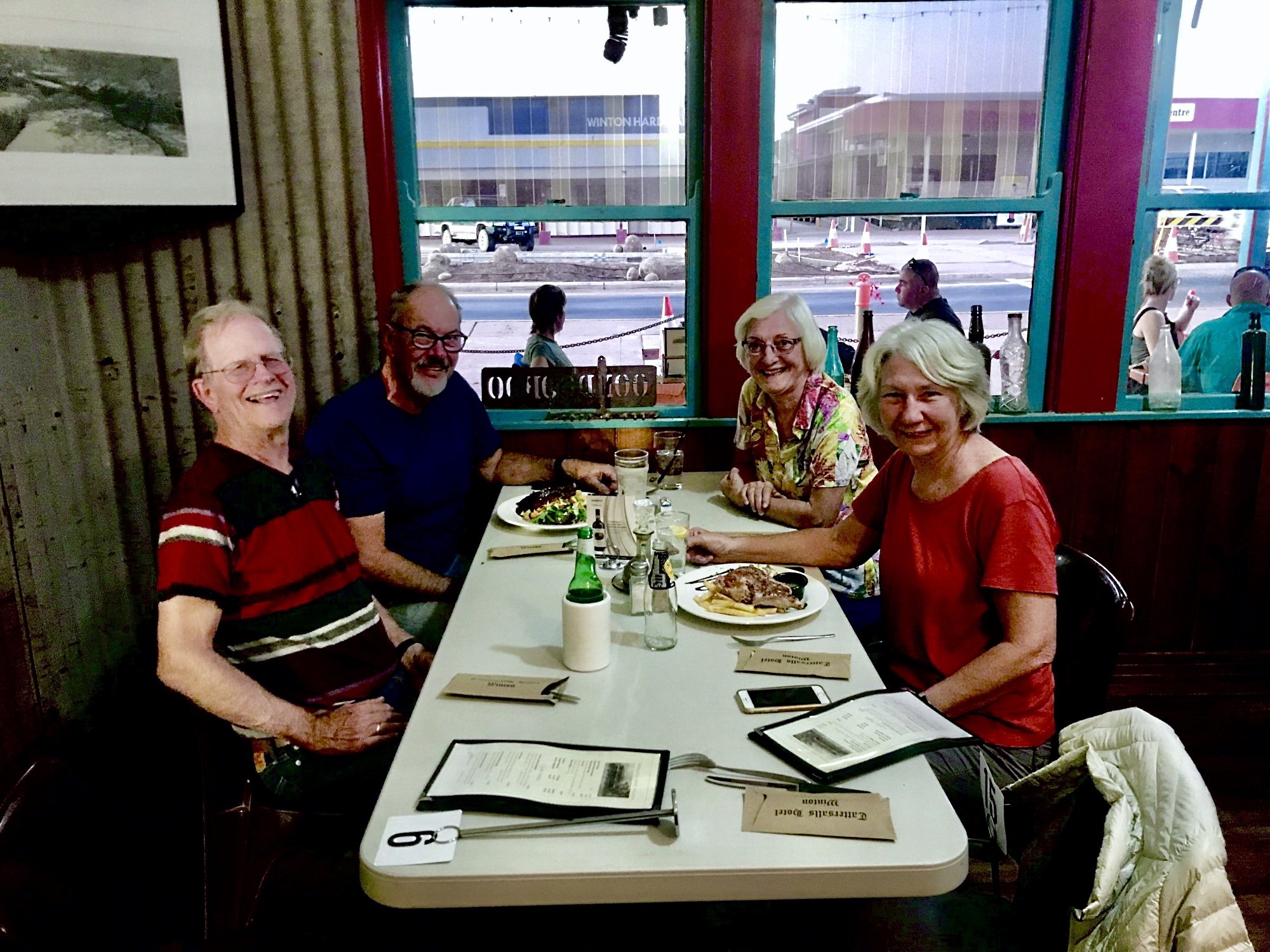
Farewell lunch in Barcaldine with Pat and Dick. You’ve been great travelling companions and I hope we’ll have more travels together in the future.
On reflection this Arnhem Land trip has been up there with the very best travel we’ve ever done, anywhere. We shared the land, the culture and the spiritualism of the oldest continuous living culture on Earth with great generosity on their behalf. This was no ‘tourist highlight’ – this was life as raw and as beautiful as it gets. We are incredibly fortunate.
And a super big thankyou to Great Divide 4X4 Tours whose ethical behaviour has seen the local indigenous communities welcome them back every year, and a really wonderful group of fellow travellers with which to share it.
To see all our photos from East Arnhem Land CLICK HERE.



